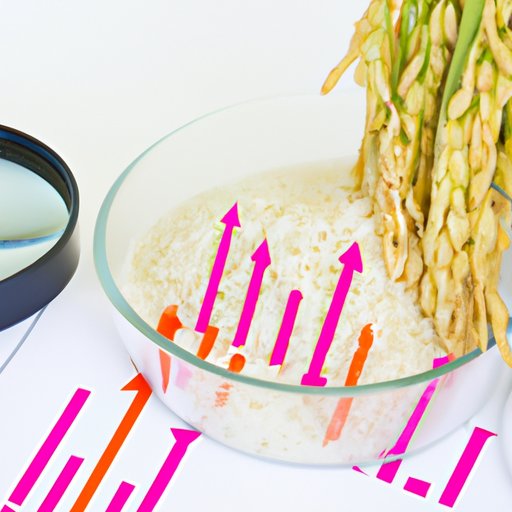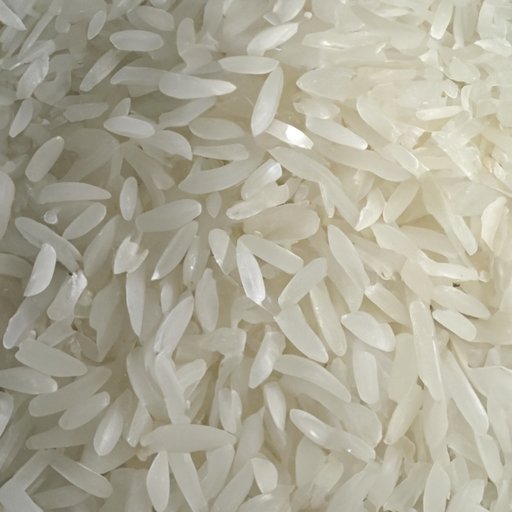Introduction
Rice is one of the most popular and versatile foods in the world. It’s a staple in many cultures and can be found in a variety of dishes. But is it healthy to eat rice every day? This article will explore the pros and cons of eating rice every day and examine the different types of rice and their impact on health.

Examining the Nutritional Profile of Rice and Its Effects on Health
Rice is a cereal grain that is high in carbohydrates and low in fat and protein. It is a good source of fiber, vitamins, and minerals. Here is a closer look at the macronutrients and micronutrients in rice:
Macronutrients in Rice
One cup of cooked white rice contains 205 calories, 45 grams of carbohydrates, 4 grams of protein, and 0.4 grams of fat. Brown rice has slightly more calories and carbohydrates but more protein and fat than white rice.
Micronutrients in Rice
Rice is an excellent source of B vitamins, including thiamin, niacin, and folate. It also contains iron, calcium, magnesium, and potassium. White rice is enriched with additional B vitamins, while brown rice is enriched with iron and calcium.
How Eating Rice Affects Your Health
Eating rice can provide your body with essential nutrients, as well as energy to power you through the day. However, it is important to note that white rice is considered a refined carbohydrate, meaning it has been stripped of some of its nutrient content. Brown rice is a whole grain, which means it contains more nutrients and fiber.
In addition, eating too much rice can lead to weight gain, as it is high in calories. Studies have also shown that eating white rice regularly can increase your risk of type 2 diabetes. This is due to its high glycemic index, meaning it causes a rapid rise in blood sugar levels.
Exploring the Pros and Cons of Eating Rice Every Day
Eating rice every day can have both positive and negative effects on your health. Let’s take a look at the potential benefits and risks associated with this dietary habit.
Potential Benefits of Eating Rice Every Day
Eating rice every day can provide your body with essential vitamins and minerals. It is also a good source of energy, which can help you stay energized throughout the day. Additionally, studies have shown that eating brown rice regularly can reduce your risk of certain chronic diseases, such as heart disease and type 2 diabetes.
Potential Risks of Eating Rice Every Day
Although there are potential benefits to eating rice every day, there are also some potential risks. Eating too much white rice can lead to weight gain, as it is high in calories and has a high glycemic index. Additionally, eating white rice regularly can increase your risk of type 2 diabetes. Finally, eating too much rice can also cause digestive issues, such as bloating and constipation.

Investigating the Different Types of Rice and Their Impact on Health
There are many different types of rice available, each with its own nutritional profile and health benefits. Here is a closer look at the different types of rice and their impact on health:
White Rice
White rice is the most commonly consumed type of rice. It is highly processed, meaning it has had most of its nutrients removed. White rice is high in calories and carbohydrates and has a high glycemic index, which can cause a rapid rise in blood sugar levels.
Brown Rice
Brown rice is a whole grain and is less processed than white rice. It is higher in fiber and protein than white rice and has a lower glycemic index. Brown rice is also enriched with essential vitamins and minerals, such as iron and calcium.
Wild Rice
Wild rice is not actually a type of rice, but rather a grass seed. It is higher in protein and fiber than other types of rice and is a good source of vitamins and minerals. Wild rice is also lower in calories and carbohydrates than other types of rice.
Black Rice
Black rice is a type of heirloom rice that is high in antioxidants and has anti-inflammatory properties. It is also rich in vitamins and minerals, such as iron and calcium. Black rice is low in calories and carbohydrates and has a low glycemic index.
Red Rice
Red rice is similar to black rice but has a slightly nuttier flavor. Like black rice, it is a good source of vitamins and minerals and is low in calories and carbohydrates. Red rice also has a low glycemic index.
Jasmine Rice
Jasmine rice is a long-grain variety of white rice. It is fragrant and has a subtle nutty flavor. Jasmine rice is high in carbohydrates and calories and has a high glycemic index.
Basmati Rice
Basmati rice is a type of long-grain rice that is often used in Indian and Middle Eastern cuisine. It is lower in carbohydrates than other types of rice and has a lower glycemic index. Basmati rice is also a good source of vitamins and minerals, such as iron and calcium.
Arborio Rice
Arborio rice is a type of short-grain rice that is often used in Italian dishes, such as risotto. It is higher in carbohydrates than other types of rice but has a lower glycemic index. Arborio rice is also a good source of vitamins and minerals, such as iron and calcium.

Assessing How Much Rice Is Too Much to Eat Every Day
Now that we’ve explored the different types of rice and their impact on health, let’s take a look at how much rice is too much to eat every day. According to the Dietary Guidelines for Americans, the recommended serving size for cooked rice is 1/2 cup (or about 105 grams). This is equivalent to about two servings per day.
When eating rice every day, it is important to consider the type of rice you are eating and the other foods in your diet. For example, if you are eating white rice, try to balance it out with other whole grain foods, such as quinoa or oats. Additionally, try to opt for brown rice over white rice whenever possible, as it is less processed and contains more nutrients.
Conclusion
In conclusion, eating rice every day can have both positive and negative effects on your health. It is important to consider the type of rice you are eating, as well as the other foods in your diet. Additionally, it is recommended to limit your intake of white rice and opt for brown rice whenever possible. By following these guidelines, you can ensure that you get the most out of your daily intake of rice.
Summary of Pros and Cons of Eating Rice Every Day
Eating rice every day can provide your body with essential vitamins and minerals, as well as energy to power you through the day. However, eating too much white rice can lead to weight gain, as it is high in calories and has a high glycemic index. Additionally, eating white rice regularly can increase your risk of type 2 diabetes. Brown rice is a better option, as it is a whole grain and contains more nutrients and fiber.
Recommendations for Eating Rice Every Day
When eating rice every day, it is important to consider the type of rice you are eating and the other foods in your diet. The recommended serving size for cooked rice is 1/2 cup (or about 105 grams), or two servings per day. Try to opt for brown rice over white rice whenever possible, as it is less processed and contains more nutrients. Additionally, make sure to balance your intake of white rice with other whole grain foods, such as quinoa or oats.
(Note: Is this article not meeting your expectations? Do you have knowledge or insights to share? Unlock new opportunities and expand your reach by joining our authors team. Click Registration to join us and share your expertise with our readers.)
